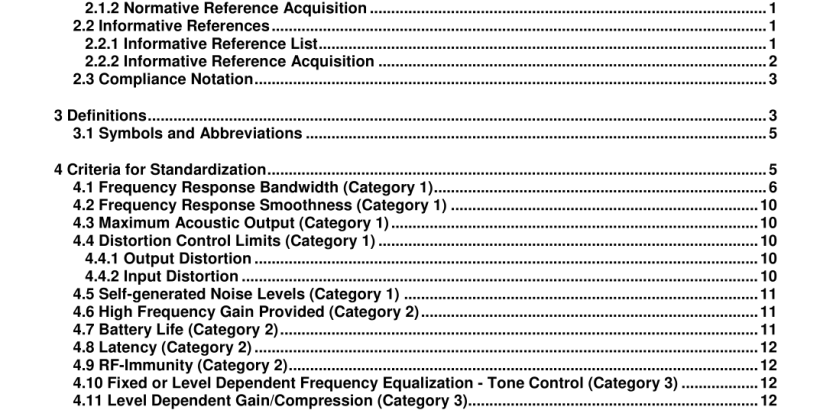ANSI CTA 2051-2017 pdf download.Personal Sound Amplification Performance Criteria
1 Scope
This standard includes technical performance metrics and associated target values for consumer products that provide personal sound amplification and/or enhancement to a user. Products shall meet the stated requirements to be considered as compliant to this standard. Personal sound amplification may be a single function within a larger set of device capabilities. Descriptions of feature specific device performance baselines and metrics of measurement are described. Device performance capabilities have been divided into feature specific sub-sections that identify: required minimum performance values, metrics of measurement necessary to identify feature specific performance values, and methods of reporting prescribed to each feature specific value.
2 Normative References
The following standards contain provisions that, through reference in this text, constitute normative provisions of this standard. At the time of publication, the editions indicated were valid. All standards are subject to revision, and parties to agreements based on this standard are encouraged to investigate the possibility of applying the most recent editions of the standards listed here.
Category 2: The description of a hearing device performance parameter which must include the value measured per the specified testing method. Category 2 requirements do not include a threshold or acceptable range for the parameter measured. Category 3: Presence of the technological capability or feature shall be reported in the device description. The specific value/metric for measurement of this value is not within the scope of the standard. Measurements in this standard specify the use of tones (sine waves) as a stimulus signal. It is recognized that many devices will include non-linear audio processing (DSP) (for example, noise suppression, band equalization) that may cause unexpected test results when tones are used as test stimulus signals. Therefore, when performing measurements using tones as specified in Section 4.1 , 4.2, 4.3, 4.4, 4.5, 4.6, and 4.7, any non-linear signal processing should be disabled. Alternatively, if using tones is not appropriate for testing a specific device, for example, due to the inability to disable non-linear processing, alternative test signals such as real speech and 1 /3 rd octave pulsed noise signals may be used. If an alternate test signal is used, 1 /3 rd octave analysis should be performed to obtain individual frequency based test results, similar to what would have been obtained if tone-based measurements were performed. As in ANSI S3.22-201 4, Section 5.2.5, controls of the device under test shall be set for the widest available frequency response range, e.g., tone control typically set for minimum effect. As in ANSI S3.22-201 4, Section 4.1 , test signal(s) shall exceed background noise by at least 1 0 dB, and unwanted stimuli shall be sufficiently low so as not to affect the test results by more than 1 dB. In addition to the tests included in this standard, it is recommended that informal listening tests be performed during both product development and final evaluation to ensure that there are no undesirable effects present that are not revealed by objective testing.
To obtain the one-third-octave insertion response, the appropriate CORFIG corrections needed to obtain insertion gain are used in each case. These CORFIG corrections are shown in Tables 4.1 A and 4.1 B for the 2cc coupler and the occluded ear-simulator coupler, respectively. When bandwidths above 8 kHz are to be verified the occluded ear simulator coupler must be used. The components underlying the overall CORFIGs are given in Table 4.1 C. For example, it shows that the choice of microphone location generally results in a small correction. The corrections provided are applicable for hearing devices with microphone positions that are typical for in the ear (ITE) and behind the ear (BTE) device configurations. If a hearing device with a microphone position other than described above is to be tested, then an appropriate correction to a diffuse field simulation may be needed to account for the device’s microphone position in addition to the corrections for the ear simulator coupling. Table 4.1 A: CORFIG corrections for converting 2cc coupler response to estimated insertion gain assuming diffuse-field measurement. Values are given for device microphone locations that are in the ear (ITE) and behind the ear (BTE) at one-third octave center frequencies (Freq).ANSI CTA 2051-2017 pdf download
